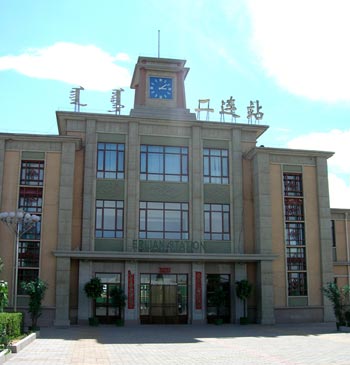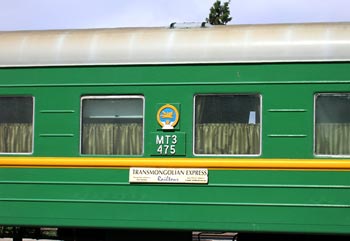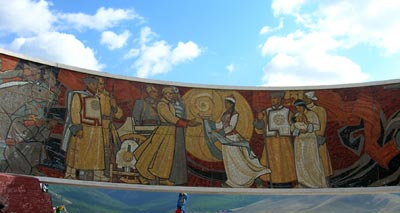 |
 |
 |
 |
|
Smugglers on the Trans-Siberian Railway
|
|||||||||||||||||||||
 |
We get up very early for a drive to Erlianhot to board the overnight train to Ulaan Baator; the drive is about six hours and we need to be at the train station a few hours before departure to go through customs. According to Mao Mao, the Chinese and the Mongolians trade off charge of the schedule, so the days on which the trains run change from year to year. Checking in is like one of those evacuation scenes from a movie where the invading army is about to enter the city: utter chaos. This makes absolutely no sense because once one gets through customs, everybody waited around on the platform until they open the doors. And compartments are assigned so there should be no dashing for the best bunks. The locals have piles of belongings, much of it packed in cheap plastic "Mikey and Mimi Mouse" bags. (Evidently these can be purchased at the Merry Mart in Beijing.) We have plenty of time to wander around the platform waiting for the train to let us on. We try shopping but it's a pretty motley selection of mostly food items (and we have already dont mega-shopping in the massive Datong supermarket). I am intrigued by the possibilities, looking at the posted destination ticket price listings. All the way to Moscow ... wow! The mind boggles. It turns out, however, that Ulaan Baator is quite far enough. |
||||||||||||||||||||
 |
|||||||||||||||||||||
 |
|||||||||||||||||||||
| I'm sharing a compartment with Ann, Georgia and Amihan, and we are in the inefficient car with the surly attendants. The other half of our group is in the more efficient car — they get their bedding and hot water right away. However, the real reason for this good service soon becomes evident: they are smuggling massive amounts of stuff into Mongolia. The men's bathroom is crammed with packages and kept locked, while even more items (some dripping with melting ice, which leads to rumors of black market body parts) are locked in ceiling storage areas of various compartments, including at least two belonging to our party. At first we can't get the compartment window open, and when the surly attendant finally unlocks it, it stays open for the duration of the trip. The train starts late, makes a little progress, stops, goes backwards and forward, adds some cars, and then changes wheels at the border. The always paranoid Russians, fearing invasion by trainloads of foreign armies, use a different track gauge from that of adjoining countries, so any train entering Russia must switch wheels at the border. Our transportation is part of the Trans-Siberian Railway, constructed with Russian technical assistance after Mongolia adopted communism in the 1920s, and goes all the way to Moscow. We are also boarded by officials who collect our passports and return them after a few hours of scrutiny. Travellers are not amused at having no access to the bathrooms for 4-6 hours. Amihan and I, fanning ourselves on our top bunks, decide to demand tribute but spare our subjects the necessity of supplying hostages or 'he qin' exchanges. Eventually we actually start moving. Around 11:30 pm I woke up and stuck my head out the window. There are millions of stars: it's beautiful. Then we enter the Gobi desert, most of which flies into our compartment and spreads a layer of loess over everything. And it's cold, but the window is stuck, so I piled the sheets over my head and try not to swallow too much desert. |
|||||||||||||||||||||
 |
After daybreak we climbed out of our berths and stood in the hallway watching the steppes: horses (hundreds of horses), camels, sheep, goats, gers, eagles, marmots — a taste of what we will be experiencing for the four days we will spend on the steppes. Mongolia is, so say the guidebooks, about the size of Alaska; but here the land seems to extend forever. The train is not an express, and there are a few stops. At the last one before Ulaan Baator, all of the smuggled packages are frantically unloaded onto the platform, the attendants and their associates pushing into every compartment to make sure nothing is left behind. It's hardly circumspect, and there is so much stuff the Mongolian officials must turn a blind eye (or take a cut). |
||||||||||||||||||||
| Across the steppes (photo by Amihan Makayan) | |||||||||||||||||||||
| There are no good hotels in Ulaan Baator. Ours is okay, but our rooms are on the fourth floor and there's no elevator. And the showers are the same (European, I'm told) style as in Jinshanling — inefficient drain in the floor. But at least this one has a curtain and hot water. The hotel restaurant, Roma, purports to be Italian, the food is dreadful and the service worse. Fortunately, the central area of UB is aiming to be a tourist mecca with a wide variety of ethnic eating places, some of which (like the Grand Khaan Irish Pub) are pretty weird. We had lunch at BD Mongolian BBQ (which has opened branches in Florida!), a fun and busy place: you choose your raw ingredients, sauces and condiments, and the staff cooks it all on a large grill. It's sort of a Mongol version of Benihana, but less formal. The guys were really skillful and seem to enjoy cooking (and showing off). There was ice cream (!) for dessert, followed by vodka. The afternoon we arrived in UB we visited the Winter Palace of the last Bogd Gegen, who until his death in 1924 was both the political and spiritual ruler of Mongolia. There was also a bit of sightseeing, including a short walk to the top of Zarsan Memorial Hill, with its sculptural murals commemorating the alliance of Mongolia and Russia in the 1930s, for a panoramic view. The city is not much to look at, but is surrounded by mountains and a huge blue sky. |
 |
||||||||||||||||||||
 |
|||||||||||||||||||||
 |
Dinner at the Renaissance Restaurant in a hotel (I think). We have switched to Western set dishes (and no beer): beef, potatoes, overcooked vegetables. We are to see many repetitions of this meal in Mongolia. After dinner, or maybe before, we saw a concert performance by the Famous National State Orchestra (or some such), which combines music, dancing, singing (including throat singing), and contortionists. The latter are mostly young girls who twist their bodies into some amazing pretzel shapes. Evidently this is a very popular thing in Mongolia — but maybe calling them acrobats would have less of a sleazy carnival side show sound. Whatever. They are very good and the music is quite lovely. The main traditional instrument is the horsehead fiddle, which has two horse hair strings and is usually played with a bow. Other instruments include the hammer dulcimer and something like a Chinese lute (lethal weapon of choice for demure-looking ladies in martial arts movies: cf Brigitte Lin in more than a few of these ...). There are also some lovely flutes and other wind instruments; I don't know their names. The dancing was colorful if somewhat touristy, reminding some of us of the dongba performance last year in Lijiang. Themes are archery and horses; there are some masked dancers representing the shamanistic rituals of Mongol culture. Speaking of which ... Mongolia has a rich history of religious and folklore traditions, beginning with a creation myth that the Mongols were descended from the coupling of a blue wolf and a fallow deer. The shamanism is pantheistic, mainly centering on worship of the blue sky. Blue is the favored color of the Mongols, and can be seen even in Buddhist temples as well as decorating the "ovoo" (piles of stones that serve as landmarks and sacred sites, and are scattered everywhere in the countryside). |
||||||||||||||||||||
| Our excursion the next day was to the Gandan Monastery, center of Buddhism in UB and the only temple left intact during the communist era purge of religious practice. Mongolia is now a Buddhist country (Tibetan Yellow Hat sect), revitalized after the change of government in 1989. Many religious treasures were hidden by the people, and the monks who weren't killed scattered. A young monk, who has lived in Gandan since he was 17, showed us around. After the monastery there was a visit to the National Museum, where Bob gave us an assignment to pick one object on our first pass through the collection, and then go back and collect more information on it. There is one room with petroglyphs, cave paintings, funeral and deer stones, dating mostly from the Neolithic and Bronze ages. Our Mongolian national guide, a lovely young woman named Tunga (who is a cancer surgeon moonlighting as a tour guide because doctors don't make much money in the current Mongolian economy) has given all of us t-shirts as a welcome gift. In the museum, I find the image from my shirt: a Neolithic petroglyph image of horses and chariot. So I decided to write about these. It's a surprise to see such a rich collection here. Some of the cave paintings are exquisite: as good as the more famous ones from southern France! with scenes of everyday life on the steppes, and the Five Animals central to Mongol life: horse, sheep, cattle (cows and yaks), goats and camels (reindeer in the north). The horse is, understandably, prominent. We have already seen many herds from the train, beautiful animals running across the steppes with mounted nomads behind. |
|||||||||||||||||||||